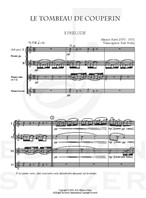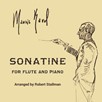
Le Tombeau de Couperin
Composer: Maurice Ravel
Instrument: Flute Quartet
Level: unknown
Published: 2015
Price: €35.00
Item details
-
Description +
-
Transcription: Erik Norby
Duration: 22 min.Le Tombeau de Couperin is originally a suite for solo piano, composed between 1914 and 1917. It’s in six movements but in 1919 Ravel orchestrated only four movements of the work (Prélude, Forlane, Menuet and Rigaudon.) The Danish composer Erik Norby orchestrated in 1986 these four movements for the Kuhlau flute quartet (two C-flutes, piccolo, alto flute and bass flute.) Because of Erik Norby’s great orchestration ability and vivid perception for Ravel´s music, this seemingly impossible task was brilliant solved. In its new form the “Le Tombeau de Coprerin” became a success both as far as the audience and music critics were concerned.
Ravel stated that his intention was never to imitate or tribute Couperin himself, but rather was to pay homage to the sensibilities of the Barogue French keyboard suite. This is reflected in the structure which imitates a Baroque dance suite. However, Ravel's neoclassicism shines through with his pointedly twentieth-century chromatic melody and piquant harmonies.
During the World War 1 Ravel himself was an ambulance driver and was wounded while serving. Each movement is dedicated to the memory of friends of the composer who had died fighting in the War. When criticised for composing a light-hearted and sometimes reflective work rather than a sombre one, for such a sombre topic, Ravel replied: "The dead are sad enough, in their eternal silence."
The movements are:I. Prélude
"To the memory of Lieutenant Jacques Charlot" (who transcribed Ravel's four-hand piece Ma Mére L’Oye for solo piano).
II. Forlane
"To the memory of Lieutenant Gabriel Deluc" (a Basque painter from Saint-Jean-de-Luz).
III. Menuet
"To the memory of Jean Dreyfus" (at whose home Ravel recuperated after he was demobilized).IV. Rigaudon
"To the memory of Pierre and Pascal Gaudin" (brothers killed by the same shell).
-
-
Instrumentation +
-
Flute Quartet
-
-
About the composer +
-
Joseph Maurice Ravel (7 March 1875 – 28 December 1937) was a French composer, pianist and conductor. He is often associated with impressionism along with his elder contemporary Claude Debussy, although both composers rejected the term. In the 1920s and '30s Ravel was internationally regarded as France's greatest living composer.
Born to a music-loving family, Ravel attended France's premier music college, the Paris Conservatoire; he was not well regarded by its conservative establishment, whose biased treatment of him caused a scandal. After leaving the conservatoire Ravel found his own way as a composer, developing a style of great clarity, incorporating elements of baroque, neoclassicism and, in his later works, jazz. He liked to experiment with musical form, as in his best-known work, Boléro (1928), in which repetition takes the place of development. He made some orchestral arrangements of other composers' music, of which his 1922 version of Mussorgsky's Pictures at an Exhibition is the best known.
As a slow and painstaking worker, Ravel composed fewer pieces than many of his contemporaries. Among his works to enter the repertoire are pieces for piano, chamber music, two piano concertos, ballet music, two operas, and eight song cycles; he wrote no symphonies or religious works. Many of his works exist in two versions: a first, piano score and a later orchestration. Some of his piano music, such as Gaspard de la nuit (1908), is exceptionally difficult to play, and his complex orchestral works such as Daphnis et Chloé (1912) require skilful balance in performance.
Ravel was among the first composers to recognise the potential of recording to bring their music to a wider public. From the 1920s, despite limited technique as a pianist or conductor, he took part in recordings of several of his works; others were made under his supervision.
-
-
Credits +
-
Photo: Sara Josefine Jönsson
Front cover graphics and layout: Ronni Kot Wenzell
Transcription: Erik Norby
Engraving: Henrik Svitzer
Printed in Copenhagen, Denmark
Copyright © Edition Svitzer
www.editionsvitzer.com
-





